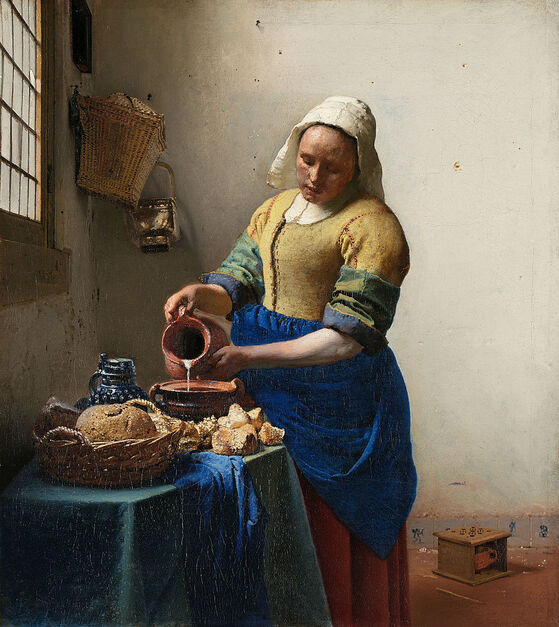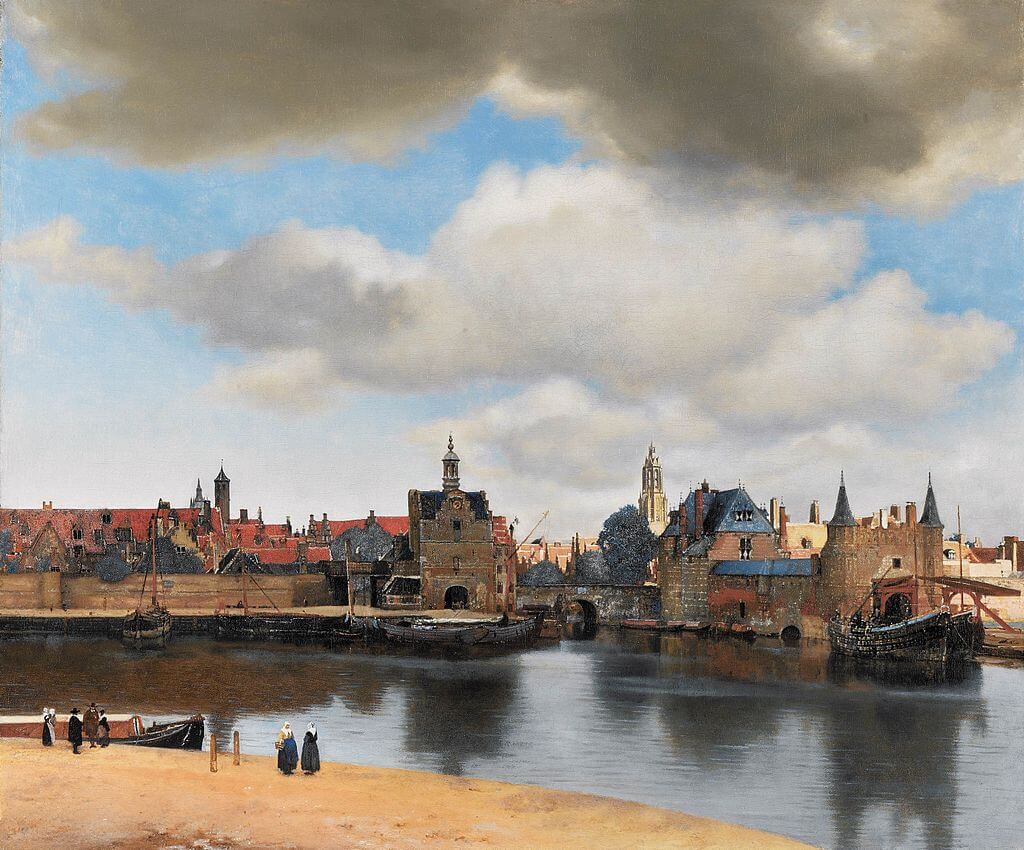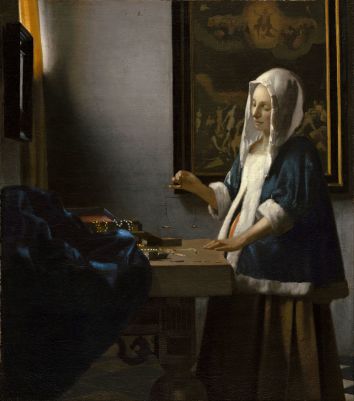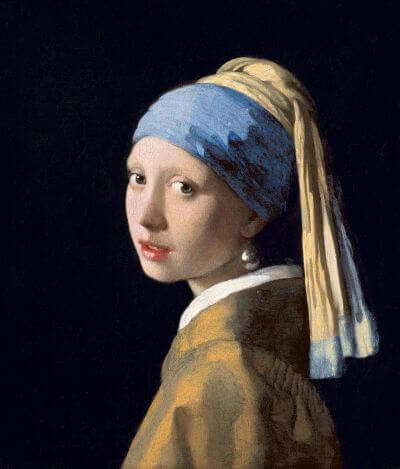|
Where? The Eregallerij on the second floor of the Rijksmuseum
When? Between 1657 and 1661 What do you see? A milkmaid is pouring milk from an earthenware jug into an earthenware cooking pot. The table is covered with a greenish cloth, and a blue cloth is hanging down from the table. The table further contains various pieces of bread, a basket with bread, and a blue stoneware jug (note the use of small bright dots by Vermeer on the bread baskets and the bread – also referred to as the pointillé technique). The girl is possibly making bread pudding in the cooking pot. She is focused on her task, and her face is expressionless. She is dressed in a white linen cap, a yellow jacket of wool, rolled-up green and blue sleeves that are not part of her jacket, a blue apron, and a red skirt. The sunlight is entering through the window on the left. Note that one piece of the glass on the right is broken. To the right of the window hangs a basket with bread on the wall. Above the basket hangs a small painting with unknown content and to the right of the basket hangs a metal container. The large wall in the back is white (with some stains) and lit up by the sunlight which enters through the window. At the bottom of this wall is a series of typical Delft Blue tiles. In front of these tiles is a foot stove to warm the feet with nine holes on the top and a bowl inside of it. The tile on the left of the stove depicts Cupid. The tile on the right of the stove depicts a man with a long walking stick. Treatment of Light? The way that Vermeer included the effects of the sunlight in this painting is particularly noteworthy. The light is most visible when looking at the walls. The wall on the left is in the shadow, and the back wall is largely lit up. You can also see various shadows on the back wall. An obvious one is the shadow of the metal container on the left of the back wall. While the window is only partially included, we can get a good idea of its real size by looking at the presence of the shadows or the lack thereof. For example, we do not see the shadow of the milkmaid, indicating that the window does not extend much to the left. However, we can see the shadow of the nail on the top of the painting (above the right shoulder of the milkmaid) indicating that the window is quite tall. Backstory: About twenty years after the death of Vermeer, 21 of his paintings were sold at an auction. This painting was sold for 175 guilders in 1696 (which is roughly equivalent to $90 at that time). After the View of Delft painting (which is now in the Mauritshuis in The Hague), it was the second most expensive painting sold during that auction and considered to be a great piece of work. The next most expensive painting was Woman Holding a Balance which is now in the National Gallery of Art in Washington, DC. The Milkmaid was acquired in 1908 by the Rijksmuseum. Recent x-ray examinations have shown that Vermeer removed a couple of items from the painting. First, Vermeer initially included a painting on the back wall. However, as paintings were quite expensive at that time, he removed it to create an empty wall to simplify the room. Second, he also initially included a clothing basket next to the bottom right of the woman’s red skirt, but he also removed this later on. He probably removed this basket to put more emphasis on the main theme of this painting and not to distract the viewer too much.
Who is Vermeer? Johannes Vermeer (1632-1675) spend his full life in Delft in The Netherlands. He is considered to be a genre painter as he uses scenes from everyday life as the theme for his paintings. Vermeer was a perfectionist and worked for months on a single painting. His work is admired because of its great harmony. He was also an expert in incorporating light into his paintings and is sometimes referred to as the ‘Master of Light’.
While Vermeer's work was appreciated during his life, Vermeer was largely forgotten after his death. It took until the second half of the 19th century for Vermeer to be rediscovered. Especially the Impressionist painters could appreciate his usage of light, and since then Vermeer has gradually become more popular again. Without a doubt, his most famous work is the Girl with a Pearl Earring in the Mauritshuis in The Hague.
What is genre art? Vermeer is considered to be genre painter. Genre art is the depiction of scenes from everyday life, such as domestic settings, markets, and life on the streets. It evolves around depicting the common people engaged in daily activities.
Genre art was popular in the 16th and especially the 17th century in Flanders and The Netherlands. Pieter Bruegel the Elder and Jan Steen are two other examples of well-known genre painters. Fun fact: The woman in this painting is not really a milkmaid. While she is pouring milk at this particular moment, she is probably a kitchen maid or a servant. A milkmaid was actually someone who milked the cows and used the milk to produce dairy products. The term milkmaid is not to be confused with the milkman, who was someone who would deliver the milk to the houses of people. Some people interpret the milkmaid in this painting in an erotic way. During Vermeer’s time, milkmaids were often considered to be a subject of male desire and they were often sexually available to their employer. These people argue that the open jug of milk, the foot stove to warm up the feet and everything under the skirt of the milkmaid, and a Delft Blue tile depicting Cupid are all subtle signs of eroticism. Interested in a copy for yourself? Poster
Written by Eelco Kappe
References:
0 Comments
Leave a Reply. |
Categories
All
|
- Home
- Blog
-
Museums
- Alte Pinakothek
- Art Institute of Chicago
- Baltimore Museum of Art
- Barber Institute of Fine Arts
- Bargello
- Barnes Foundation
- British Museum
- Church of Sant’Anastasia
- Cleveland Museum of Art
- Courtauld Institute of Art
- Detroit Institute of Arts
- Frans Hals Museum
- Galleria Borghese
- Gallerie dell'Accademia
- Getty Museum
- Guggenheim
- Hermitage Museum
- Kunsthistorisches Museum
- Kunstmuseum Basel
- Legion of Honor Museum
- Louvre
- Mauritshuis
- Metropolitan Museum of Art
- Musee d’Orsay
- Museum of Fine Arts in Boston
- Museum of Modern Art
- National Gallery in London
- National Gallery of Art
- National Museum in Poznań
- Norton Simon Museum
- Ny Carlsberg Glyptotek
- Palace of Versailles
- Palazzo Pitti
- Palazzo Vecchio
- Petit Palais
- Philadelphia Museum of Art
- Prado
- Pushkin Museum
- Ravenna Art Museum
- Rijksmuseum
- San Diego Museum of Art
- Santa Maria delle Grazie
- St. Peter's Basilica
- Städel Museum
- Statens Museum for Kunst
- Tate Britain
- Tate Modern
- Timken Museum of Art
- Uffizi
- Vatican Museums
- Wallace Collection
-
Artists
- Altdorfer
- Anguissola
- Berlin Painter
- Bosch
- Botticelli
- Boucher
- Bronzino
- Bruegel the Elder
- Brunelleschi
- Cabanel
- Caillebotte
- Canova
- Caravaggio
- Carpeaux
- Cezanne
- Cimabue
- David
- Degas
- Delacroix
- De Maria
- Donatello
- El Greco
- Fontana
- Fra Angelico
- Fragonard
- Gauguin
- Gentileschi
- Gericault
- Gonzalez-Torres
- Goya
- Hals
- Hogarth
- Hokusai
- Ingres
- Leonardo da Vinci
- Lippi, Filippo
- Longhi, Barbara
- Lorrain
- Makovsky
- Manet
- Massys
- Matisse
- Merian
- Michelangelo
- Mochi
- Modigliani
- Monet
- Panini
- Parmigianino
- Perugino
- Picasso
- Pisanello
- Raphael
- Rembrandt
- Renoir
- Reynolds
- Rivera
- Rodin
- Rubens
- Scultori
- Seurat
- Steen
- Tintoretto
- Titian
- Toulouse-Lautrec
- Turner
- Uccello
- Van der Weyden
- Van Dyck
- Van Eyck
- Van Gogh
- Van Hemessen
- Vasari
- Velazquez
- Vermeer
- Veronese
- Vigée Le Brun
-
Locations
- Books
- About Us




